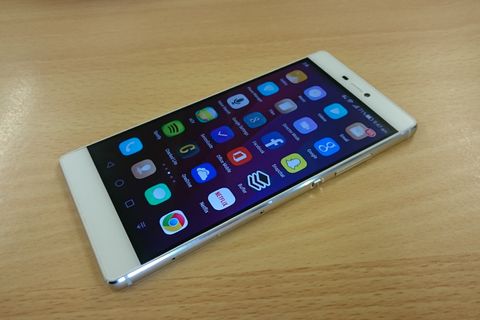IT Pro Verdict
With a very reasonable pricetag and a rather excellent camera, the Huawei P8 is a pretty compelling mid-range handset. It’s not perfect, but if you’re looking for quality on a budget, you could do a lot worse.
Pros
- +
Excellent design; Spectacular camera; Very capable display
Cons
- -
'Knuckle Sense' sometimes interferes with touch controls; Could be a little cheaper
The Huawei P8 is the Chinese company's latest attempt to horn in on the global smartphone market currently dominated by Apple, Samsung and HTC.
While it's by no means faultless, the P8 is a surprisingly capable and well-made device, and does everything you could reasonably expect it to without leaving you too much out of pocket.
Huawei has now launched the P8's successor, and it's a bit of a cracker. Like the P8 before it, the Huawei P9 is attractively built, with a highly capable camera and a pleasingly modest price tag.
It's not an unqualified success, but it's further proof that Huawei is a force to be reckoned with when it comes to quality mid-range handsets. If you want to know more, have a look at our full Huawei P9 review.
Huawei P8: price and availability
The Huawei P8 is targeted at the same price-bracket as its predecessor. It's priced pretty boldy (From 499 or 359 at current rates),considering phones like the HTC One M8 and Samsung Galaxy S5 are retailing for around the same figure.
However, Huawei is confident that, like Apple, a strong aesthetic and polished experience will be enough to support a slightly expensive price tag. What's more, we've got a hunch the firm might well be right.
Huawei P8: design
Last year's Ascend P7 was a beautiful device, and Huawei has once again impressed us with its design chops - the P8 is gorgeous. The aluminium unibody and bevelled edges make it a pleasure to hold, and the screen-to-body ratio is fantastically low.
We can't shake the feeling we've seen it somewhere before, though. Twin bands at the top and bottom of the body and an aluminium casing in a choice of grey or pale gold seem incredibly reminiscent of another major smartphone

Yes, it has to be said that the P8 bears an unusually striking resemblance to Apple's latest crop of iPhones. This is no bad thing, however, and the Huawei P8 feels light, well-balanced and comfortable to hold.
It's also unbelievably thin at just 6.4mm. Huawei has actually managed to shave a little off last year's P7, which is an impressive feat given how slim it already was. For comparison, the barely-there iPhone 6 is 6.9mm, so when we say the P8 is one of the thinnest phones we've ever seen, it's not an exaggeration.
The bevelled edge - rather attractively picked out in silver - also make it look even thinner than it is to begin with. Huawei has gone to town on giving its latest product a properly premium feel, and it's massively paid off.
Huawei P8: display
While many of its bigger-budget rivals have gone for QHD screens, the P8 sports a more modest 1080p resolution for its 5.2in IPS display. However, while a better resolution sounds great on paper, it's wholly unnecessary for the vast majority of users.
Full HD is more than sufficient for most people, who'll be using it mainly for YouTube clips and TV streaming. In addition to this, it's also much lighter on the power consumption than more impressive displays.
Aging though it might be, 1080p is no slouch and in daily use the P8's screen is actually very good. The 5.2in screen is nice and vivid, with high contrast and great brightness levels ensuring that text is crisp and easy to read, even in bright sunlight.
Huawei P8: 'knuckle sense'
For the P8, Huawei has developed rich touch, an input system that they claim is the next leap forward in user control. This takes the form of knuckle sense, which is about as sensible as it sounds.
The idea is that the P8's screen can tell the difference between a knuckle and a finger, thereby opening up new functions and inputs. So far, these consist of double-tapping with a knuckle to save a screenshot, or drawing with a knuckle to crop out a specific selection.
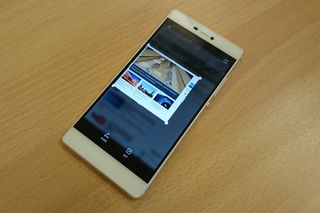
In theory, this is a fine notion, although it slightly over-estimates the importance of screenshots in daily life. However, in practice, we found that the P8 got a little confused between our finger and our knuckle, taking screenshots when it wasn't supposed to and mistaking swipe gestures for crop selections.
However, none of our fellow P8-wielding colleagues have experienced this problem, so it could just be an issue with our model. On the other hand, if it is a widespread problem, it's a serious mis-step, and one that proves the adage "if it ain't broke, don't fix it."
Huawei P8: software
The P8 ships with Android Lollipop 5.0, not that you'd know as it comes with Huawei's own Emotion UI laid over the top. It's virtually unrecognisable as Android, which is either going to be a plus or a minus depending on your own personal feelings - visually, it's a dead ringer for iOS, complete with a lack of dedicated apps drawer.
Instead, apps go directly onto the home screen, thence to be organised or sorted into folders as you choose. As habitual Android users, this confounded us at first. However, it's easy enough to adapt to, and iOS migrants will be right at home.
If you do have trouble locating apps, a Spotlight-style search feature has now been added that allows you to search messages, apps and contacts. The icons for native apps are also very iOS-like, with rounded, visually-consistent boxes as opposed to Android 5.0's more free-form approach.
Recent apps have also been given a makeover. Rather than the Rolodex-esque card layout introduced by the Lollipop update, Huawei has opted for two rows of windows which scroll from left to right. From the user's perspective, it works in a similar way to iOS' app-switching mechanic.
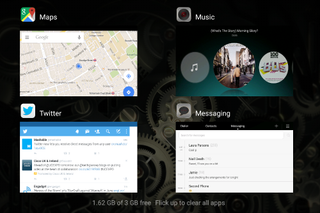
It does boast a couple of very nifty software features lacking from other phones, though. A quick swipe of the notification bar, for example, will see the screen shrunk down by about 50 per cent, bringing it into the bottom left or right corner for easy one-handed use.
You can also add a button to the navigation bar that will instantly lower or retract the notifications screen, which can be very handy for quickly checking alerts without responding to them.
The notifications screen, rather than using Android 5.0's cards system, uses a chronological calendar layout that we found oddly pleasing. It feels a lot more professional and organised than base Android's notifications.
Huawei P8: camera
As with the P7, Huawei is still putting a lot of emphasis on the camera. The 13MP snapper boasts "best-in-class" optical image stabilisation and a dedicated, DSLR-standard image processing chip, which ensures all your snaps will come out looking their very best.
We found that with the automatic settings enabled, all our photos came out looking pin-sharp and superbly focused, both for selfies and for longer-distance landscape shots.

It's also pre-loaded with a bunch of fun effects tools, including modes for shooting light-painting' photos and car light trails. Ideal if you want an easy way to get some more arty shots.
One especially interesting feature is the director mode, which allows the P8 to use up to three additional smartphones as slave cameras to produce multi-angle videos. You can flick between the different views instantly while recording, and then save them for viewing at your leisure.
It's also got something called 'perfect selfie' mode which uses facial recognition to automatically enhance your appearance in group photos. Among other variables, there's the option to thin your face, enlarge your eyes and smooth out your skin-tone.
The end result can leave you looking like a living anime cartoon straight out of the Uncanny Valley. This seems like a sure-fire hit with sociopaths who want to ensure that they look better than all their friends, but otherwise, we're not convinced.
Huawei P8: specs and hardware
Things are a little more interesting in the spec department. The P8 comes equipped with a Kirin930 octacore processor - four cores are clocked at 2GHz for CPU-intensive tasks, with four 1.5GHz cores for less demanding operations, all backed up by a solid 3GB of RAM.
The P8 uses different combinations of these cores depending on the individual situation, in an effort to boost both performance and battery life. Huawei claims that this provides an 80 per cent speed increase over the P7 and, while we might not go that far, there have definitely been some improvements.
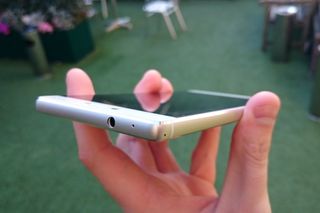
The more capable processor bumped up the P8's GeekBench 3 single-core results to 855, and almost doubled the P7's multi-core score with a total of 3346. That's not all that far behind the HTC One M9, and it's reflected in the phone's crisp and responsive performance.
Our other benchmarks proved a little more troubling, though. The SunSpider browser test tripped it up, recording a result of 1011.6ms. Not only is that substantially lower than last generation's flagships, it's also bafflingly worse than the P7's score last year.
However, despite these dismaying results, the P8 feels snappy and capable when browsing the web. We encountered surprisingly few problems with load times or missing elements.
Where the P8 did have issues was in the gaming department. The Mali chip powering the P8's GPU is getting on a bit, and it shows - our 3D gaming benchmark, using GFXBench's onscreen T-Rex test, yielded a measly 18fps.
This is a lot worse than its big-budget rivals, and when playing graphically-intensive games like Real Racing 3, the framerate has a tendency to fall off a cliff. Basic commuter fare like Candy Crush Saga or Temple Run shouldn't present a problem, but forget about anything overly flashy.
Storage is in line with what you'd expect. The P8 has a tiered pricing structure, with 16 and 64GB versions available. However, since it also features expandable storage via microSD, there's not a huge amount of point in the more expensive option.
Connectivity is similarly run-of-the-mill, with Bluetooth 4.0, single-band 802.11b/g/n Wi-Fi and LTE 4G. NFC is a nice touch, but otherwisethere's nothing particularly special to see here.
Huawei P8: battery
The P8's 2,600mAh battery has a stated life of one day of heavy use, or 1.5 days of normal use. Generally, this holds up, although judicious management of brightness and background apps can sometimes be required for more taxing tasks.
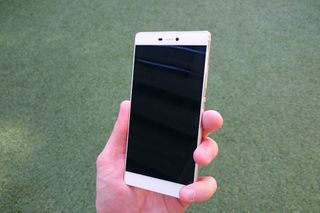
Huawei is aware of how much impact background processes can have on battery life. In order to combat this, it has introduced a sort of firewall system, whereby apps drawn excessive amounts of background power are flagged up, and can be closed if necessary.
However, this is of debatable usefulness. It can get incredibly irritating when trying to multi-task, for example, as the system will often flag up apps that you've only temporarily navigated away from.
Huawei P8: other features
The P8 comes in both single and dual-SIM variations, with the microSD slot pulling double duty as a SIM tray when the expandable storage isn't in use. Huawei has even bunged in a useful utility for managing which SIM handles mobile data, calls and texts.
It also sports twin antennas, which are designed to prevent users blocking the signal with their hand as part of a system Huawei calls Signal+. Unless you live or work near a signal black-spot, you're unlikely to notice the difference, but it's reassuring nevertheless.
Wi-Fi+, similarly, will endeavour to find the strongest wireless signal available. This works well, but given that most people will only have access to one network at a time, we're again struggling to see the point.
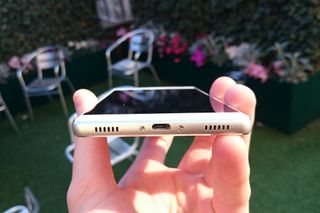
To complete the series, the P8 also sports a Roaming+' mode, which swiftly connects you to the best available network upon landing in a foreign country. Sure to please the jet-set, and a great tool for business travellers.
The P8 still lags behind mainstream rivals in the waterproofing stakes; while it has splash-resistant nano-coating, it's still lacking a proper IP rating that would allow it to be fully submerged. It's a shame, as we're rapidly coming to treat full water-resistance as a must-have feature.
It's got some interesting tricks up its sleeve to compensate, though, including a 'loud mode' for taking phone calls in noisy areas and an automatic international dialer to remove the hassle of inputting country codes. There's also beefed-up handsfree capability to pick up voice from up to two metres away.
The handsfree in particular is a highlight. Not only does it deliver on its claims of perfectly clear pickup from a fair distance away, it also leverages the handset's rather sterling speaker to project with clarity and volume.
By far the coolest, however, is the 'find my phone' style locator. By using a voice command - "Hey, Buddy" by default - you can wake up your phone. Ask it where it is, and it will light up, vibrate and cheerily proclaim "Here I am!"
What's even better is the fact the commands are customisable, so the varied profanities you inevitably exclaim whenever you lose a device could, in this case, actually help you find it.
Huawei P8: verdict
Overall, the Huawei P8 is a cracker of a phone. Not only does it look the absolute business, it's a breeze to use. Die-hard Androidites might take umbrage with their beloved OS being Appled-up', but it's undeniably slick.
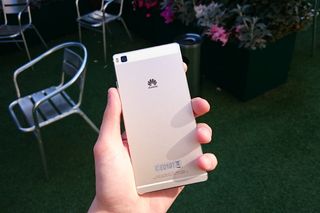
It's not got the best screen around and the knuckle sense' software throws the occasional wobbly. However, it makes up for it with possibly the best camera we've ever seen on a mid-range device.
Verdict
With a very reasonable pricetag and a rather excellent camera, the Huawei P8 is a pretty compelling mid-range handset. It’s not perfect, but if you’re looking for quality on a budget, you could do a lot worse.
Processor: Kirin930 2/1.5GHz octacore CPU
GPU: Mali T624
Display: 5.2in Full-HD IPS panel
Memory: 3GB RAM
Storage: 16/64GB options
Connectivity: 802.11b/g/n
Ports: MicroUSB 2.0, 3.5mm headphone jack, MicroSD, Nano SIM
Dimensions: 144.9 x 72.1 x 6.4 mm
Weight: 144g
Adam Shepherd has been a technology journalist since 2015, covering everything from cloud storage and security, to smartphones and servers. Over the course of his career, he’s seen the spread of 5G, the growing ubiquity of wireless devices, and the start of the connected revolution. He’s also been to more trade shows and technology conferences than he cares to count.
Adam is an avid follower of the latest hardware innovations, and he is never happier than when tinkering with complex network configurations, or exploring a new Linux distro. He was also previously a co-host on the ITPro Podcast, where he was often found ranting about his love of strange gadgets, his disdain for Windows Mobile, and everything in between.
You can find Adam tweeting about enterprise technology (or more often bad jokes) @AdamShepherUK.
